A Comprehensive Research Report: The Ebola Virus Outbreak in Nigeria
VerifiedAdded on 2021/04/21
|23
|5203
|44
Report
AI Summary
This research report provides a comprehensive analysis of the 2014 Ebola virus outbreak in Nigeria. It begins with background information on the outbreak, including its unprecedented scope and impact across multiple countries, and then poses research questions concerning the Nigerian government and healthcare workers' containment efforts. The report aims to forecast how Nigeria effectively coordinated and contained the outbreak. It includes a literature review defining Ebola, detailing its high-risk factors, and outlining treatment measures. The study employs both primary and secondary data collection methods, including literature reviews and questionnaire surveys of hospital heads, international organizations, and NGOs involved in the Ebola response. The methodology incorporates qualitative and quantitative approaches, using journal articles and questionnaires to evaluate the healthcare models, social impact, and disease control strategies employed. The discussion section analyzes the outbreak's impact, the strategies used, and the factors behind the successful containment of the virus. The report concludes with an assessment of the outbreak and the effectiveness of the health care measures.
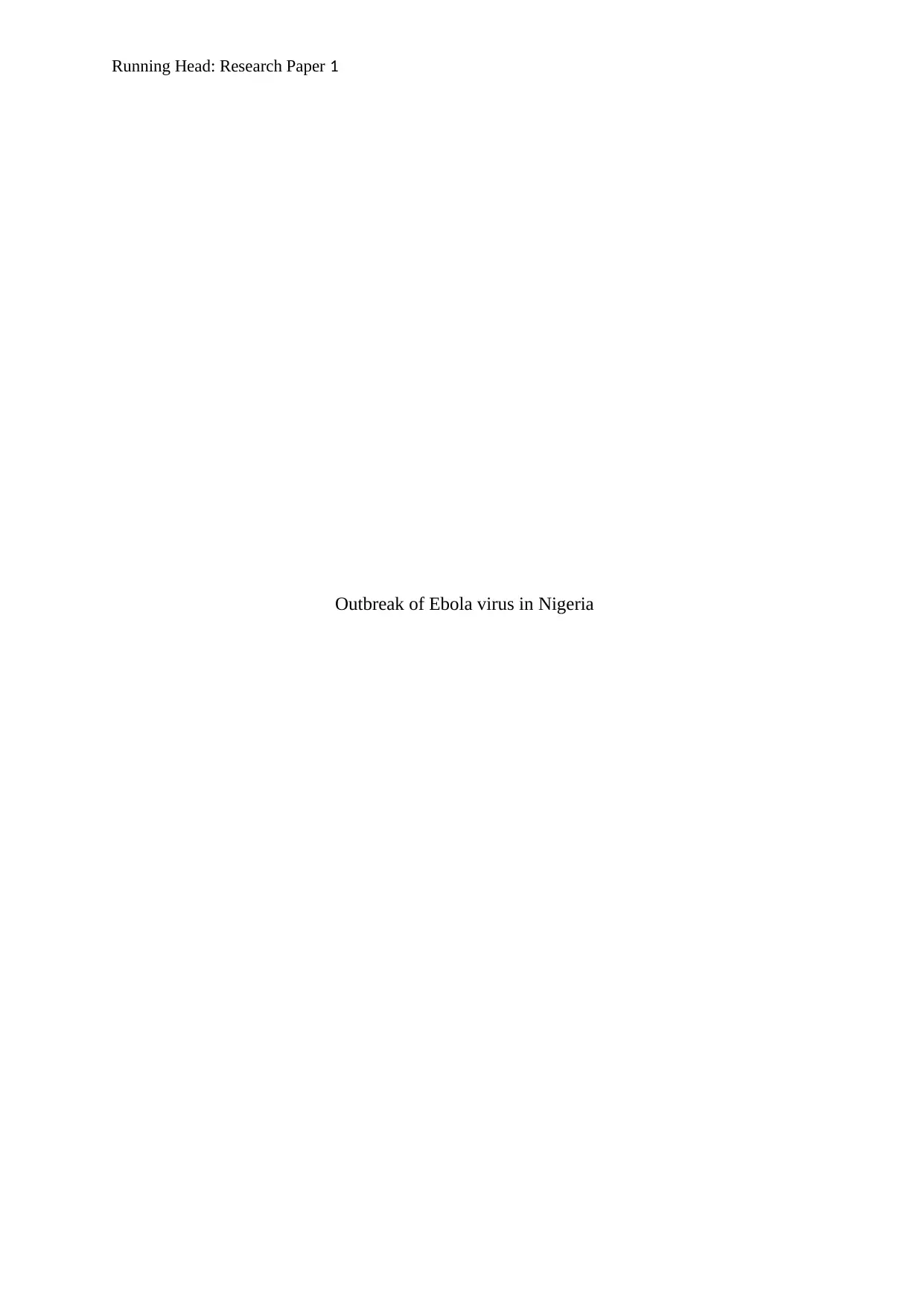
Running Head: Research Paper 1
Outbreak of Ebola virus in Nigeria
Outbreak of Ebola virus in Nigeria
Paraphrase This Document
Need a fresh take? Get an instant paraphrase of this document with our AI Paraphraser

Research Paper 2
Contents
CHAPTER 1: INRODUCTION.................................................................................................3
Background information............................................................................................................3
1.2 Research Questions..........................................................................................................3
1.3. Research Aim and Objectives.........................................................................................3
Chapter 2: literature review........................................................................................................4
Chapter 3: Data collection..........................................................................................................6
Chapter 4: Methodology............................................................................................................7
Chapter 5: Discussion................................................................................................................7
5.1 Data analysis.....................................................................................................................8
Chapter 6: Conclusion..............................................................................................................17
References................................................................................................................................18
Appendix..................................................................................................................................22
Questionnaire........................................................................................................................22
Contents
CHAPTER 1: INRODUCTION.................................................................................................3
Background information............................................................................................................3
1.2 Research Questions..........................................................................................................3
1.3. Research Aim and Objectives.........................................................................................3
Chapter 2: literature review........................................................................................................4
Chapter 3: Data collection..........................................................................................................6
Chapter 4: Methodology............................................................................................................7
Chapter 5: Discussion................................................................................................................7
5.1 Data analysis.....................................................................................................................8
Chapter 6: Conclusion..............................................................................................................17
References................................................................................................................................18
Appendix..................................................................................................................................22
Questionnaire........................................................................................................................22
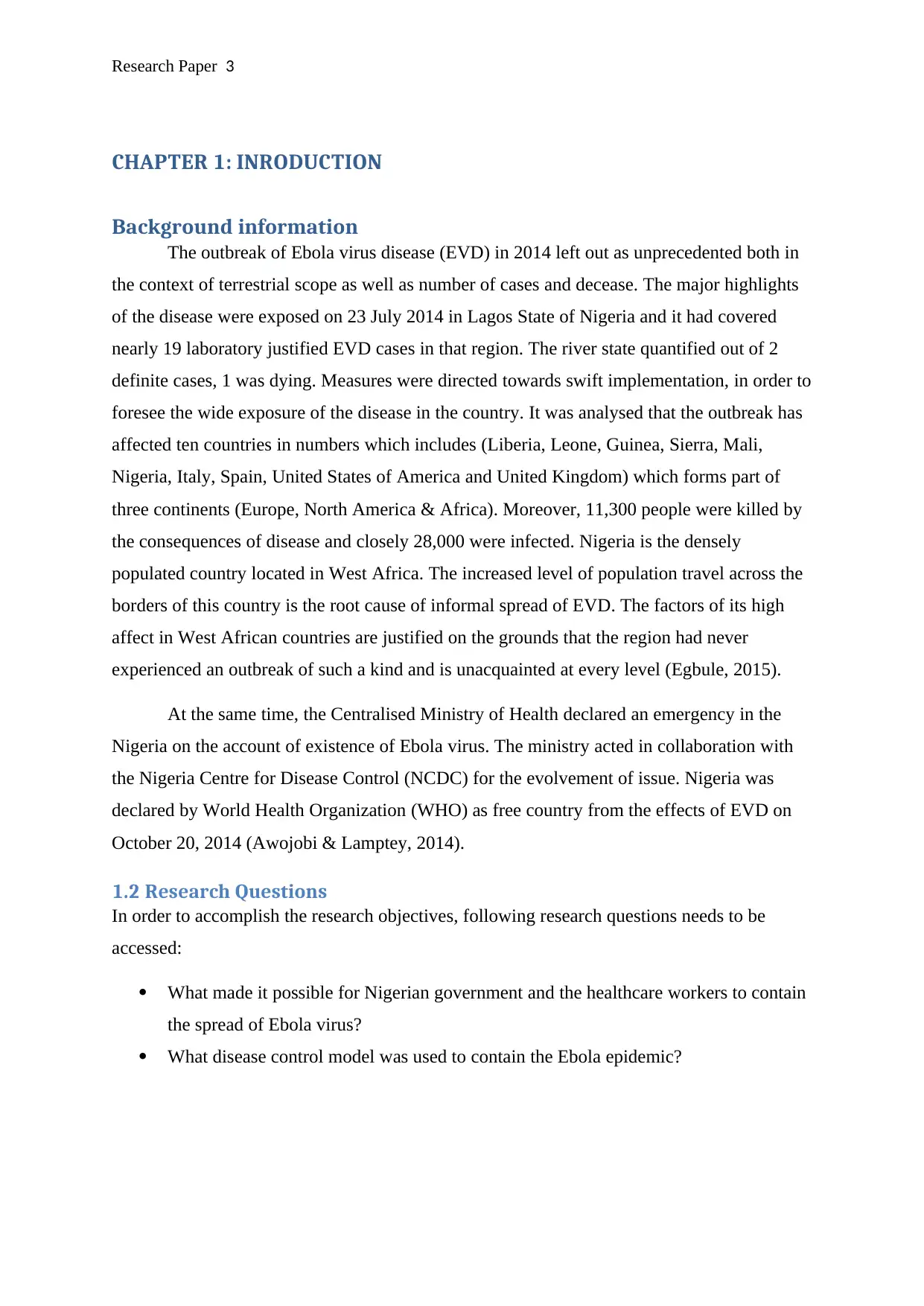
Research Paper 3
CHAPTER 1: INRODUCTION
Background information
The outbreak of Ebola virus disease (EVD) in 2014 left out as unprecedented both in
the context of terrestrial scope as well as number of cases and decease. The major highlights
of the disease were exposed on 23 July 2014 in Lagos State of Nigeria and it had covered
nearly 19 laboratory justified EVD cases in that region. The river state quantified out of 2
definite cases, 1 was dying. Measures were directed towards swift implementation, in order to
foresee the wide exposure of the disease in the country. It was analysed that the outbreak has
affected ten countries in numbers which includes (Liberia, Leone, Guinea, Sierra, Mali,
Nigeria, Italy, Spain, United States of America and United Kingdom) which forms part of
three continents (Europe, North America & Africa). Moreover, 11,300 people were killed by
the consequences of disease and closely 28,000 were infected. Nigeria is the densely
populated country located in West Africa. The increased level of population travel across the
borders of this country is the root cause of informal spread of EVD. The factors of its high
affect in West African countries are justified on the grounds that the region had never
experienced an outbreak of such a kind and is unacquainted at every level (Egbule, 2015).
At the same time, the Centralised Ministry of Health declared an emergency in the
Nigeria on the account of existence of Ebola virus. The ministry acted in collaboration with
the Nigeria Centre for Disease Control (NCDC) for the evolvement of issue. Nigeria was
declared by World Health Organization (WHO) as free country from the effects of EVD on
October 20, 2014 (Awojobi & Lamptey, 2014).
1.2 Research Questions
In order to accomplish the research objectives, following research questions needs to be
accessed:
What made it possible for Nigerian government and the healthcare workers to contain
the spread of Ebola virus?
What disease control model was used to contain the Ebola epidemic?
CHAPTER 1: INRODUCTION
Background information
The outbreak of Ebola virus disease (EVD) in 2014 left out as unprecedented both in
the context of terrestrial scope as well as number of cases and decease. The major highlights
of the disease were exposed on 23 July 2014 in Lagos State of Nigeria and it had covered
nearly 19 laboratory justified EVD cases in that region. The river state quantified out of 2
definite cases, 1 was dying. Measures were directed towards swift implementation, in order to
foresee the wide exposure of the disease in the country. It was analysed that the outbreak has
affected ten countries in numbers which includes (Liberia, Leone, Guinea, Sierra, Mali,
Nigeria, Italy, Spain, United States of America and United Kingdom) which forms part of
three continents (Europe, North America & Africa). Moreover, 11,300 people were killed by
the consequences of disease and closely 28,000 were infected. Nigeria is the densely
populated country located in West Africa. The increased level of population travel across the
borders of this country is the root cause of informal spread of EVD. The factors of its high
affect in West African countries are justified on the grounds that the region had never
experienced an outbreak of such a kind and is unacquainted at every level (Egbule, 2015).
At the same time, the Centralised Ministry of Health declared an emergency in the
Nigeria on the account of existence of Ebola virus. The ministry acted in collaboration with
the Nigeria Centre for Disease Control (NCDC) for the evolvement of issue. Nigeria was
declared by World Health Organization (WHO) as free country from the effects of EVD on
October 20, 2014 (Awojobi & Lamptey, 2014).
1.2 Research Questions
In order to accomplish the research objectives, following research questions needs to be
accessed:
What made it possible for Nigerian government and the healthcare workers to contain
the spread of Ebola virus?
What disease control model was used to contain the Ebola epidemic?
⊘ This is a preview!⊘
Do you want full access?
Subscribe today to unlock all pages.

Trusted by 1+ million students worldwide
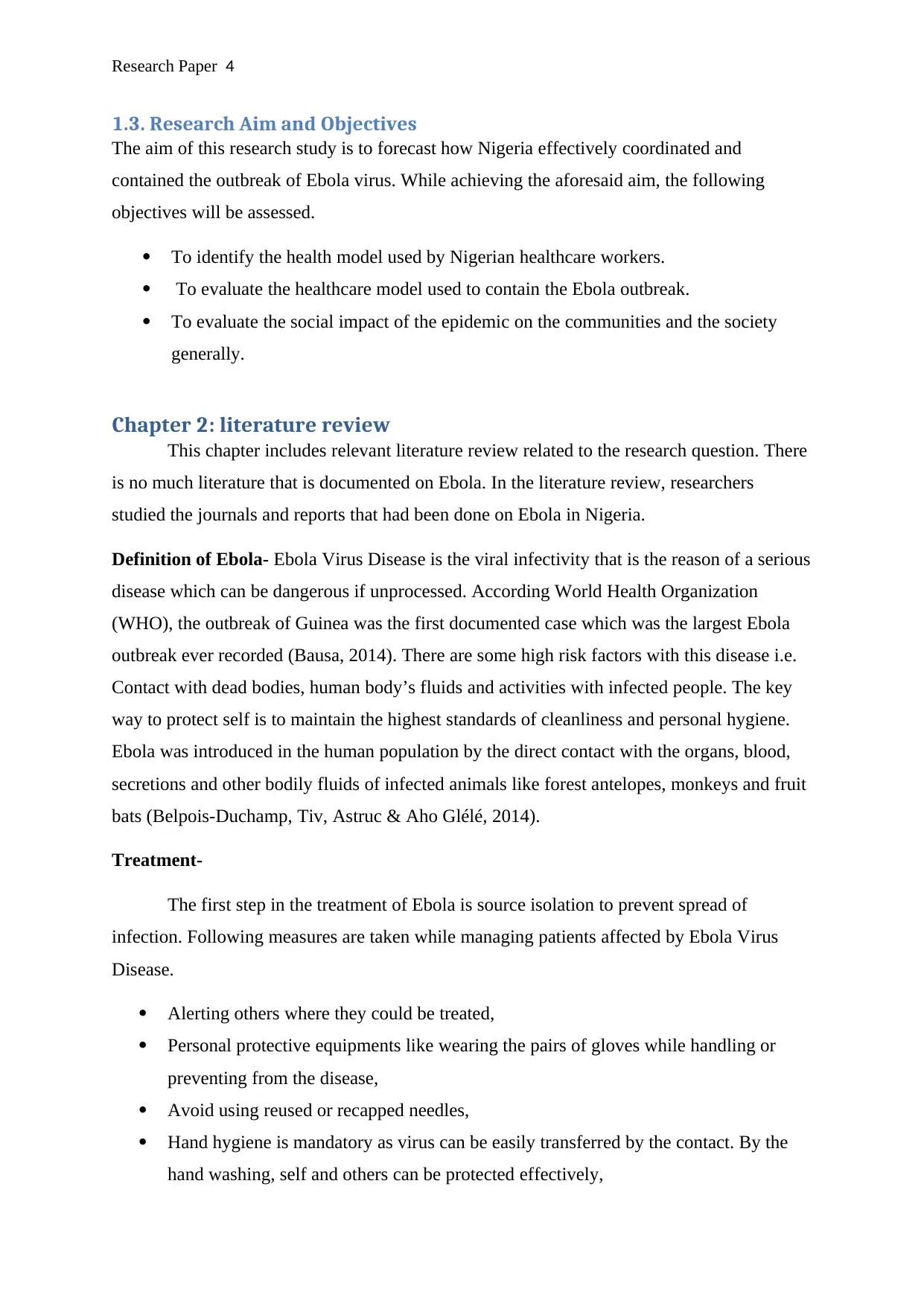
Research Paper 4
1.3. Research Aim and Objectives
The aim of this research study is to forecast how Nigeria effectively coordinated and
contained the outbreak of Ebola virus. While achieving the aforesaid aim, the following
objectives will be assessed.
To identify the health model used by Nigerian healthcare workers.
To evaluate the healthcare model used to contain the Ebola outbreak.
To evaluate the social impact of the epidemic on the communities and the society
generally.
Chapter 2: literature review
This chapter includes relevant literature review related to the research question. There
is no much literature that is documented on Ebola. In the literature review, researchers
studied the journals and reports that had been done on Ebola in Nigeria.
Definition of Ebola- Ebola Virus Disease is the viral infectivity that is the reason of a serious
disease which can be dangerous if unprocessed. According World Health Organization
(WHO), the outbreak of Guinea was the first documented case which was the largest Ebola
outbreak ever recorded (Bausa, 2014). There are some high risk factors with this disease i.e.
Contact with dead bodies, human body’s fluids and activities with infected people. The key
way to protect self is to maintain the highest standards of cleanliness and personal hygiene.
Ebola was introduced in the human population by the direct contact with the organs, blood,
secretions and other bodily fluids of infected animals like forest antelopes, monkeys and fruit
bats (Belpois-Duchamp, Tiv, Astruc & Aho Glélé, 2014).
Treatment-
The first step in the treatment of Ebola is source isolation to prevent spread of
infection. Following measures are taken while managing patients affected by Ebola Virus
Disease.
Alerting others where they could be treated,
Personal protective equipments like wearing the pairs of gloves while handling or
preventing from the disease,
Avoid using reused or recapped needles,
Hand hygiene is mandatory as virus can be easily transferred by the contact. By the
hand washing, self and others can be protected effectively,
1.3. Research Aim and Objectives
The aim of this research study is to forecast how Nigeria effectively coordinated and
contained the outbreak of Ebola virus. While achieving the aforesaid aim, the following
objectives will be assessed.
To identify the health model used by Nigerian healthcare workers.
To evaluate the healthcare model used to contain the Ebola outbreak.
To evaluate the social impact of the epidemic on the communities and the society
generally.
Chapter 2: literature review
This chapter includes relevant literature review related to the research question. There
is no much literature that is documented on Ebola. In the literature review, researchers
studied the journals and reports that had been done on Ebola in Nigeria.
Definition of Ebola- Ebola Virus Disease is the viral infectivity that is the reason of a serious
disease which can be dangerous if unprocessed. According World Health Organization
(WHO), the outbreak of Guinea was the first documented case which was the largest Ebola
outbreak ever recorded (Bausa, 2014). There are some high risk factors with this disease i.e.
Contact with dead bodies, human body’s fluids and activities with infected people. The key
way to protect self is to maintain the highest standards of cleanliness and personal hygiene.
Ebola was introduced in the human population by the direct contact with the organs, blood,
secretions and other bodily fluids of infected animals like forest antelopes, monkeys and fruit
bats (Belpois-Duchamp, Tiv, Astruc & Aho Glélé, 2014).
Treatment-
The first step in the treatment of Ebola is source isolation to prevent spread of
infection. Following measures are taken while managing patients affected by Ebola Virus
Disease.
Alerting others where they could be treated,
Personal protective equipments like wearing the pairs of gloves while handling or
preventing from the disease,
Avoid using reused or recapped needles,
Hand hygiene is mandatory as virus can be easily transferred by the contact. By the
hand washing, self and others can be protected effectively,
Paraphrase This Document
Need a fresh take? Get an instant paraphrase of this document with our AI Paraphraser

Research Paper 5
Close monitoring of blood pressure is essential
Maintaining hydration level to control the disease
The Ebola virus disease had spread to major cities with the channel of international air
travel. It forms prominent part of the unparalleled epidemic which started off in Guinea
within the era of December 2013. In current time, the virulent infection is the concern in all
over the world but there are various health care measures are taken in the Ebola-infected
areas. Ebola Virus Disease (EVD) is basically haemorrhagic fever which is challenging
societies, health workers and health systems of various countries across the world (Diakite,
2014). It is very important that health workers and nurses are trying to contain the disease
effectively and providing safe and secure care to those who are affected with this disease. By
the time, this issue has been become a serious challenge for the health sector (Miller, 2016).
According to World Health Organization (WHO), Ebola is the serious issue that needs to be
addressed on the urgent basis. Due to Ebola, current death rate in West Africa is 50% and
now it is affecting other countries i.e. Sierra Leone, Guinea and Nigeria. These are those
countries that have unable and inadequate health systems along with widespread poverty. In
order to contain the infection, the training is provided to the health workers (Duru, 2016).
WHO and International Red Cross are the part of the international workforce making
efforts data collection, treatment, co-ordination and containment. It is observed that infected
people are still not getting effective treatment in many countries as there are not enough beds,
and aid agencies. Along with this, there is the shortage of doctors, health workers and nurses
(Lupamo & Tavakolipanah, 2016). Despite of risks of infection to themselves, nurses, doctors
and other health workers with the government and non-government workers are on the
ground of Nigeria in order deal with EVD. Overcoming from misinformation and myths is
the big part of community efforts to deal with the disease and to get early treatment of the
affected people (Gsteiger, Althaus & Shuaib, 2015). For this, nurses need to have special
training to stop the disease. According to International Council of Nurses, in 14 districts in
the country, around 568 nurses has received training related to Ebola care, information,
measures and treatment to prevent its spread including safe burial of death. Along with this,
ICN also pointed out the government and organizations need to focus on addressing the
impact of Ebola on people by ensuring that they are receiving adequate and appropriate
training, protective equipments and support to deal with the disease. It is not easy for the
health workers to deal and manage the disease. For instance, it is observed that The Nigerian
nurse who cared for the victim has died. Along with this, according to Australian news team
Close monitoring of blood pressure is essential
Maintaining hydration level to control the disease
The Ebola virus disease had spread to major cities with the channel of international air
travel. It forms prominent part of the unparalleled epidemic which started off in Guinea
within the era of December 2013. In current time, the virulent infection is the concern in all
over the world but there are various health care measures are taken in the Ebola-infected
areas. Ebola Virus Disease (EVD) is basically haemorrhagic fever which is challenging
societies, health workers and health systems of various countries across the world (Diakite,
2014). It is very important that health workers and nurses are trying to contain the disease
effectively and providing safe and secure care to those who are affected with this disease. By
the time, this issue has been become a serious challenge for the health sector (Miller, 2016).
According to World Health Organization (WHO), Ebola is the serious issue that needs to be
addressed on the urgent basis. Due to Ebola, current death rate in West Africa is 50% and
now it is affecting other countries i.e. Sierra Leone, Guinea and Nigeria. These are those
countries that have unable and inadequate health systems along with widespread poverty. In
order to contain the infection, the training is provided to the health workers (Duru, 2016).
WHO and International Red Cross are the part of the international workforce making
efforts data collection, treatment, co-ordination and containment. It is observed that infected
people are still not getting effective treatment in many countries as there are not enough beds,
and aid agencies. Along with this, there is the shortage of doctors, health workers and nurses
(Lupamo & Tavakolipanah, 2016). Despite of risks of infection to themselves, nurses, doctors
and other health workers with the government and non-government workers are on the
ground of Nigeria in order deal with EVD. Overcoming from misinformation and myths is
the big part of community efforts to deal with the disease and to get early treatment of the
affected people (Gsteiger, Althaus & Shuaib, 2015). For this, nurses need to have special
training to stop the disease. According to International Council of Nurses, in 14 districts in
the country, around 568 nurses has received training related to Ebola care, information,
measures and treatment to prevent its spread including safe burial of death. Along with this,
ICN also pointed out the government and organizations need to focus on addressing the
impact of Ebola on people by ensuring that they are receiving adequate and appropriate
training, protective equipments and support to deal with the disease. It is not easy for the
health workers to deal and manage the disease. For instance, it is observed that The Nigerian
nurse who cared for the victim has died. Along with this, according to Australian news team
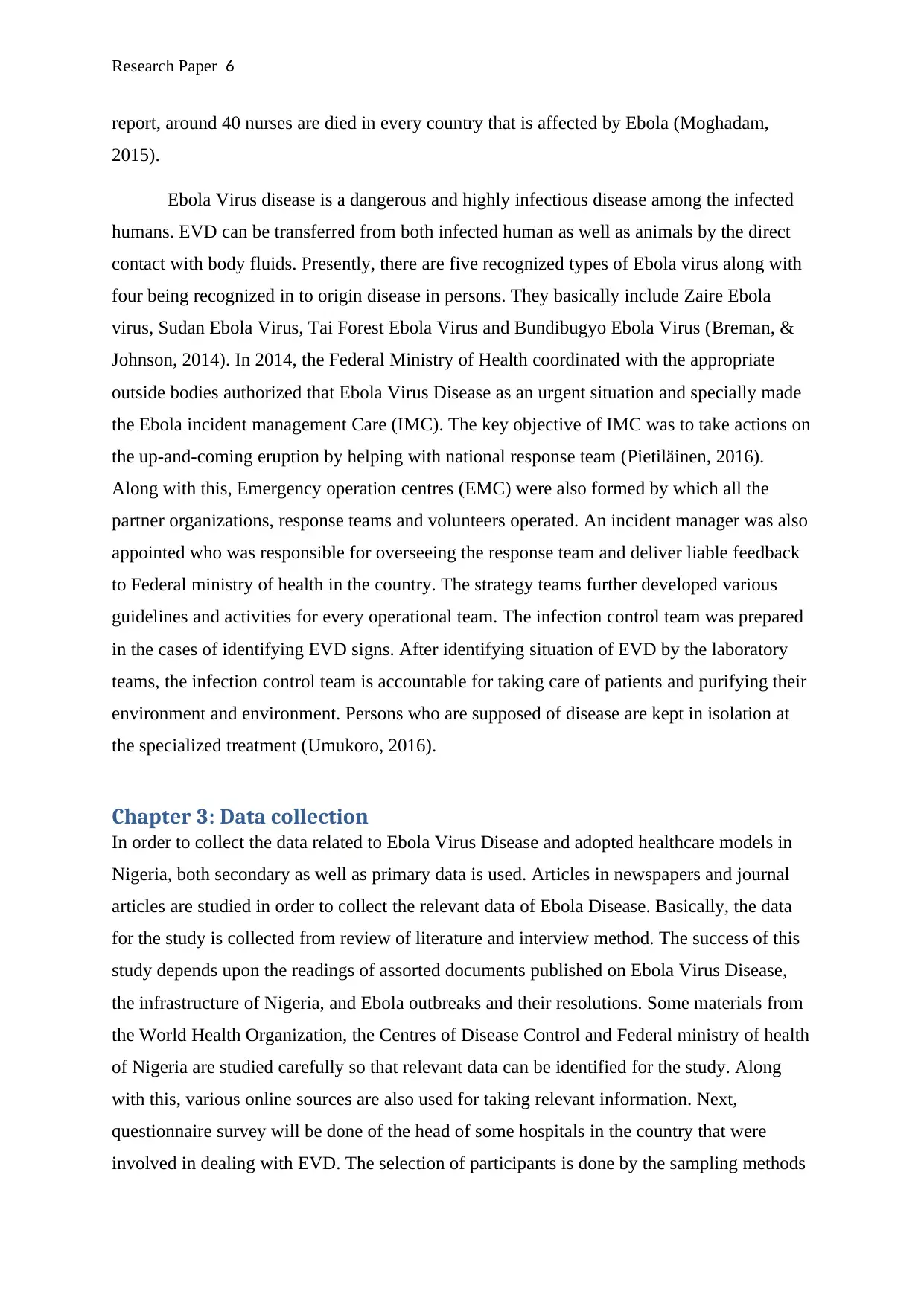
Research Paper 6
report, around 40 nurses are died in every country that is affected by Ebola (Moghadam,
2015).
Ebola Virus disease is a dangerous and highly infectious disease among the infected
humans. EVD can be transferred from both infected human as well as animals by the direct
contact with body fluids. Presently, there are five recognized types of Ebola virus along with
four being recognized in to origin disease in persons. They basically include Zaire Ebola
virus, Sudan Ebola Virus, Tai Forest Ebola Virus and Bundibugyo Ebola Virus (Breman, &
Johnson, 2014). In 2014, the Federal Ministry of Health coordinated with the appropriate
outside bodies authorized that Ebola Virus Disease as an urgent situation and specially made
the Ebola incident management Care (IMC). The key objective of IMC was to take actions on
the up-and-coming eruption by helping with national response team (Pietiläinen, 2016).
Along with this, Emergency operation centres (EMC) were also formed by which all the
partner organizations, response teams and volunteers operated. An incident manager was also
appointed who was responsible for overseeing the response team and deliver liable feedback
to Federal ministry of health in the country. The strategy teams further developed various
guidelines and activities for every operational team. The infection control team was prepared
in the cases of identifying EVD signs. After identifying situation of EVD by the laboratory
teams, the infection control team is accountable for taking care of patients and purifying their
environment and environment. Persons who are supposed of disease are kept in isolation at
the specialized treatment (Umukoro, 2016).
Chapter 3: Data collection
In order to collect the data related to Ebola Virus Disease and adopted healthcare models in
Nigeria, both secondary as well as primary data is used. Articles in newspapers and journal
articles are studied in order to collect the relevant data of Ebola Disease. Basically, the data
for the study is collected from review of literature and interview method. The success of this
study depends upon the readings of assorted documents published on Ebola Virus Disease,
the infrastructure of Nigeria, and Ebola outbreaks and their resolutions. Some materials from
the World Health Organization, the Centres of Disease Control and Federal ministry of health
of Nigeria are studied carefully so that relevant data can be identified for the study. Along
with this, various online sources are also used for taking relevant information. Next,
questionnaire survey will be done of the head of some hospitals in the country that were
involved in dealing with EVD. The selection of participants is done by the sampling methods
report, around 40 nurses are died in every country that is affected by Ebola (Moghadam,
2015).
Ebola Virus disease is a dangerous and highly infectious disease among the infected
humans. EVD can be transferred from both infected human as well as animals by the direct
contact with body fluids. Presently, there are five recognized types of Ebola virus along with
four being recognized in to origin disease in persons. They basically include Zaire Ebola
virus, Sudan Ebola Virus, Tai Forest Ebola Virus and Bundibugyo Ebola Virus (Breman, &
Johnson, 2014). In 2014, the Federal Ministry of Health coordinated with the appropriate
outside bodies authorized that Ebola Virus Disease as an urgent situation and specially made
the Ebola incident management Care (IMC). The key objective of IMC was to take actions on
the up-and-coming eruption by helping with national response team (Pietiläinen, 2016).
Along with this, Emergency operation centres (EMC) were also formed by which all the
partner organizations, response teams and volunteers operated. An incident manager was also
appointed who was responsible for overseeing the response team and deliver liable feedback
to Federal ministry of health in the country. The strategy teams further developed various
guidelines and activities for every operational team. The infection control team was prepared
in the cases of identifying EVD signs. After identifying situation of EVD by the laboratory
teams, the infection control team is accountable for taking care of patients and purifying their
environment and environment. Persons who are supposed of disease are kept in isolation at
the specialized treatment (Umukoro, 2016).
Chapter 3: Data collection
In order to collect the data related to Ebola Virus Disease and adopted healthcare models in
Nigeria, both secondary as well as primary data is used. Articles in newspapers and journal
articles are studied in order to collect the relevant data of Ebola Disease. Basically, the data
for the study is collected from review of literature and interview method. The success of this
study depends upon the readings of assorted documents published on Ebola Virus Disease,
the infrastructure of Nigeria, and Ebola outbreaks and their resolutions. Some materials from
the World Health Organization, the Centres of Disease Control and Federal ministry of health
of Nigeria are studied carefully so that relevant data can be identified for the study. Along
with this, various online sources are also used for taking relevant information. Next,
questionnaire survey will be done of the head of some hospitals in the country that were
involved in dealing with EVD. The selection of participants is done by the sampling methods
⊘ This is a preview!⊘
Do you want full access?
Subscribe today to unlock all pages.

Trusted by 1+ million students worldwide
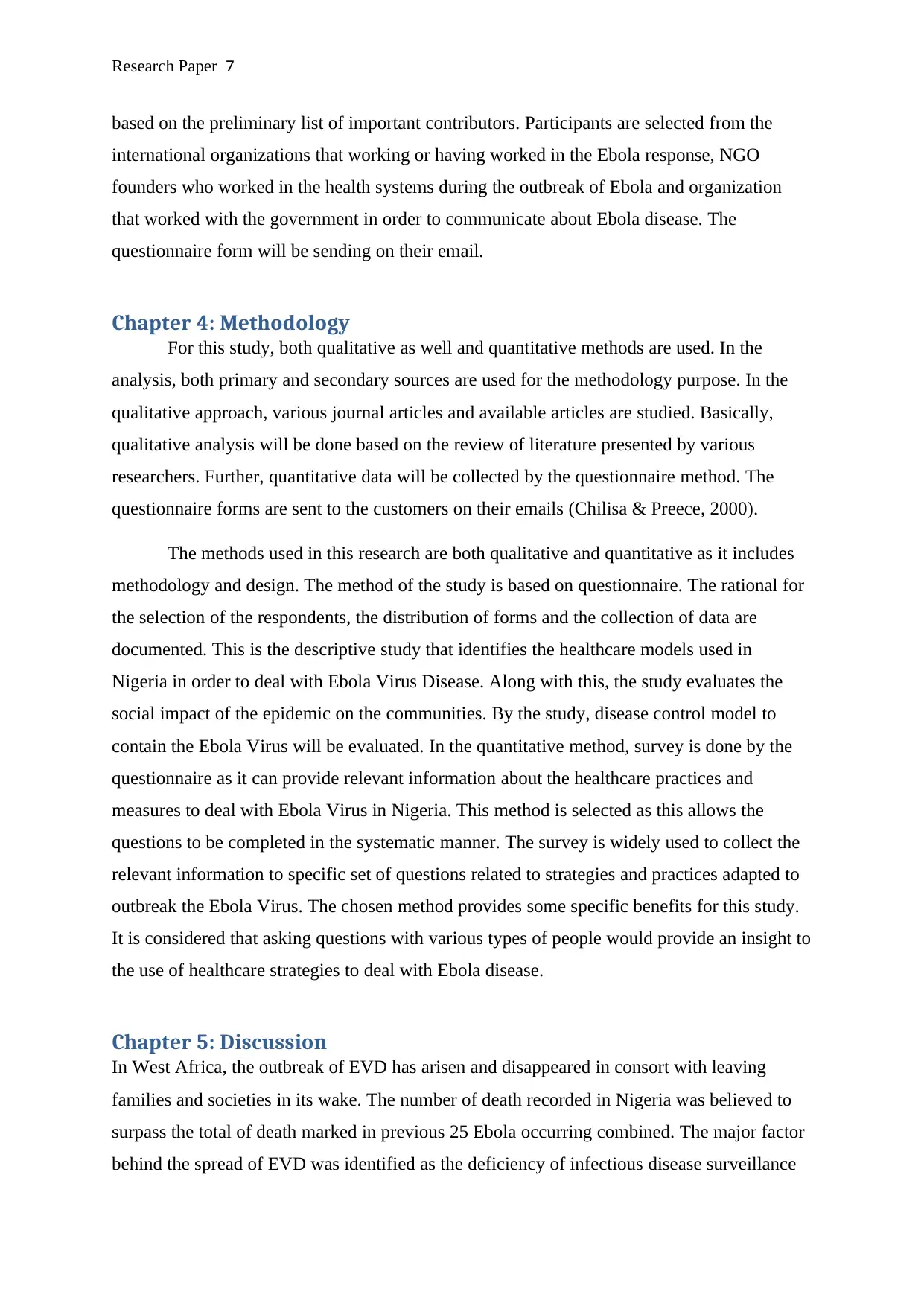
Research Paper 7
based on the preliminary list of important contributors. Participants are selected from the
international organizations that working or having worked in the Ebola response, NGO
founders who worked in the health systems during the outbreak of Ebola and organization
that worked with the government in order to communicate about Ebola disease. The
questionnaire form will be sending on their email.
Chapter 4: Methodology
For this study, both qualitative as well and quantitative methods are used. In the
analysis, both primary and secondary sources are used for the methodology purpose. In the
qualitative approach, various journal articles and available articles are studied. Basically,
qualitative analysis will be done based on the review of literature presented by various
researchers. Further, quantitative data will be collected by the questionnaire method. The
questionnaire forms are sent to the customers on their emails (Chilisa & Preece, 2000).
The methods used in this research are both qualitative and quantitative as it includes
methodology and design. The method of the study is based on questionnaire. The rational for
the selection of the respondents, the distribution of forms and the collection of data are
documented. This is the descriptive study that identifies the healthcare models used in
Nigeria in order to deal with Ebola Virus Disease. Along with this, the study evaluates the
social impact of the epidemic on the communities. By the study, disease control model to
contain the Ebola Virus will be evaluated. In the quantitative method, survey is done by the
questionnaire as it can provide relevant information about the healthcare practices and
measures to deal with Ebola Virus in Nigeria. This method is selected as this allows the
questions to be completed in the systematic manner. The survey is widely used to collect the
relevant information to specific set of questions related to strategies and practices adapted to
outbreak the Ebola Virus. The chosen method provides some specific benefits for this study.
It is considered that asking questions with various types of people would provide an insight to
the use of healthcare strategies to deal with Ebola disease.
Chapter 5: Discussion
In West Africa, the outbreak of EVD has arisen and disappeared in consort with leaving
families and societies in its wake. The number of death recorded in Nigeria was believed to
surpass the total of death marked in previous 25 Ebola occurring combined. The major factor
behind the spread of EVD was identified as the deficiency of infectious disease surveillance
based on the preliminary list of important contributors. Participants are selected from the
international organizations that working or having worked in the Ebola response, NGO
founders who worked in the health systems during the outbreak of Ebola and organization
that worked with the government in order to communicate about Ebola disease. The
questionnaire form will be sending on their email.
Chapter 4: Methodology
For this study, both qualitative as well and quantitative methods are used. In the
analysis, both primary and secondary sources are used for the methodology purpose. In the
qualitative approach, various journal articles and available articles are studied. Basically,
qualitative analysis will be done based on the review of literature presented by various
researchers. Further, quantitative data will be collected by the questionnaire method. The
questionnaire forms are sent to the customers on their emails (Chilisa & Preece, 2000).
The methods used in this research are both qualitative and quantitative as it includes
methodology and design. The method of the study is based on questionnaire. The rational for
the selection of the respondents, the distribution of forms and the collection of data are
documented. This is the descriptive study that identifies the healthcare models used in
Nigeria in order to deal with Ebola Virus Disease. Along with this, the study evaluates the
social impact of the epidemic on the communities. By the study, disease control model to
contain the Ebola Virus will be evaluated. In the quantitative method, survey is done by the
questionnaire as it can provide relevant information about the healthcare practices and
measures to deal with Ebola Virus in Nigeria. This method is selected as this allows the
questions to be completed in the systematic manner. The survey is widely used to collect the
relevant information to specific set of questions related to strategies and practices adapted to
outbreak the Ebola Virus. The chosen method provides some specific benefits for this study.
It is considered that asking questions with various types of people would provide an insight to
the use of healthcare strategies to deal with Ebola disease.
Chapter 5: Discussion
In West Africa, the outbreak of EVD has arisen and disappeared in consort with leaving
families and societies in its wake. The number of death recorded in Nigeria was believed to
surpass the total of death marked in previous 25 Ebola occurring combined. The major factor
behind the spread of EVD was identified as the deficiency of infectious disease surveillance
Paraphrase This Document
Need a fresh take? Get an instant paraphrase of this document with our AI Paraphraser

Research Paper 8
capacity prevailed in West Africa. The experience of an outbreak of such infectious disease
was nil. The embedded version of new context from an old disease is favoured as major
reflection in spread of EVD. The speedy control of the flow of EVD in Nigeria was expedited
by measures of comprehensive contact tracing, in addition the foundation of index case as
well as segregation of subordinate cases. The time gap in between of arrival and its detection,
thereby allowed for its infectious and deadly speedy coverage.
In the midst of several uncertainties, which formed part of initial limited days of EVD
reaction in Nigeria, the regulatory authorities of Lagos Sate delivered the intense leadership
along with the joint efforts of Federal Ministry. The massive support of private sector plus
international community was hitched using the approach of incident management, which was
synchronised by the efforts of EOC. A total of about 894 acquaintances were acknowledged
and nearly 18,500 person to person visits were made in regards of assessment of EVD
symptoms. Some others tracing exercise implemented involve phone histories and flight
exhibits.
For the treatment of cases, secondary in nature initially there was lack of isolation
facilities. Priority should be given towards the endowment of isolation facilities and skills
enhancement of health care personnel. Considerably, the enactment of former will lead to the
out breaking of harmful disease in African settings. Even before the outbreak of EVD in
Nigeria, the professionals from the Centre for disease control and prevention (CDC) had
directed efforts on the training and development of approximately 100 physicians on the
subject matter of epidemiology. As a result, it acted as a robust response towards the threat
befallen. The faceoff social enlistment using multimodal policies was an evident factor in
response of Nigeria to the disease. There was a crystal clear mirror effect reported with
electronic channels i.e. Facebook and twitter. It also ensured the effectiveness of propagating
educational constituents. In the adverse circumstances, e-communication devices should be
used at the extreme level as it becomes best common platform. Also, it provides wide
coverage which could drive behaviour change at great pace as well. The widespread rumour
was vital which states that consumption of bitter cola along with salt could antidote EVD
(Pharr & Ezeanolue, 2016).
5.1 Data analysis
This section includes analysis of data gathered from the answers in the questionnaire.
In the first part of questionnaire, personal information of the respondents is given. The
capacity prevailed in West Africa. The experience of an outbreak of such infectious disease
was nil. The embedded version of new context from an old disease is favoured as major
reflection in spread of EVD. The speedy control of the flow of EVD in Nigeria was expedited
by measures of comprehensive contact tracing, in addition the foundation of index case as
well as segregation of subordinate cases. The time gap in between of arrival and its detection,
thereby allowed for its infectious and deadly speedy coverage.
In the midst of several uncertainties, which formed part of initial limited days of EVD
reaction in Nigeria, the regulatory authorities of Lagos Sate delivered the intense leadership
along with the joint efforts of Federal Ministry. The massive support of private sector plus
international community was hitched using the approach of incident management, which was
synchronised by the efforts of EOC. A total of about 894 acquaintances were acknowledged
and nearly 18,500 person to person visits were made in regards of assessment of EVD
symptoms. Some others tracing exercise implemented involve phone histories and flight
exhibits.
For the treatment of cases, secondary in nature initially there was lack of isolation
facilities. Priority should be given towards the endowment of isolation facilities and skills
enhancement of health care personnel. Considerably, the enactment of former will lead to the
out breaking of harmful disease in African settings. Even before the outbreak of EVD in
Nigeria, the professionals from the Centre for disease control and prevention (CDC) had
directed efforts on the training and development of approximately 100 physicians on the
subject matter of epidemiology. As a result, it acted as a robust response towards the threat
befallen. The faceoff social enlistment using multimodal policies was an evident factor in
response of Nigeria to the disease. There was a crystal clear mirror effect reported with
electronic channels i.e. Facebook and twitter. It also ensured the effectiveness of propagating
educational constituents. In the adverse circumstances, e-communication devices should be
used at the extreme level as it becomes best common platform. Also, it provides wide
coverage which could drive behaviour change at great pace as well. The widespread rumour
was vital which states that consumption of bitter cola along with salt could antidote EVD
(Pharr & Ezeanolue, 2016).
5.1 Data analysis
This section includes analysis of data gathered from the answers in the questionnaire.
In the first part of questionnaire, personal information of the respondents is given. The
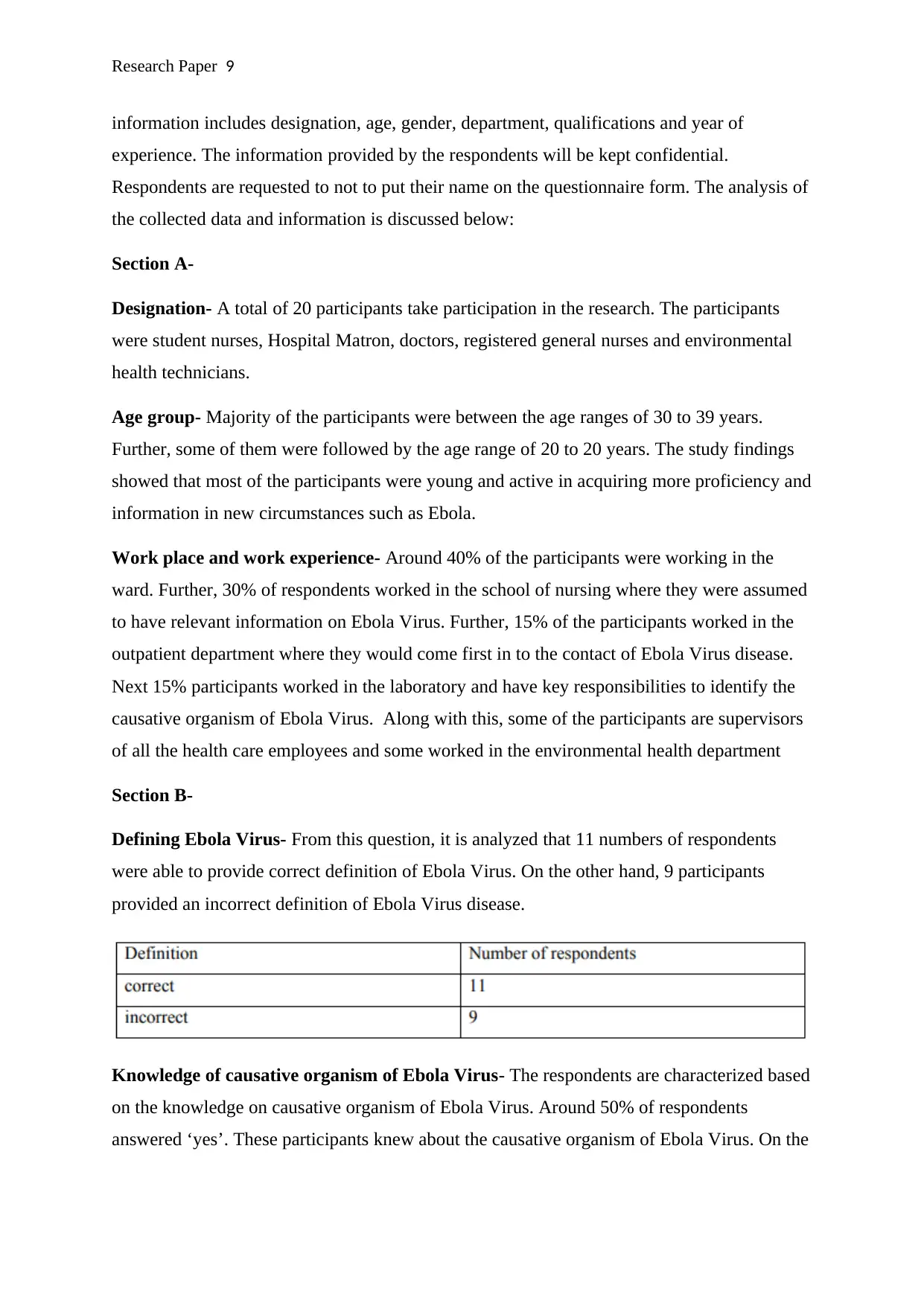
Research Paper 9
information includes designation, age, gender, department, qualifications and year of
experience. The information provided by the respondents will be kept confidential.
Respondents are requested to not to put their name on the questionnaire form. The analysis of
the collected data and information is discussed below:
Section A-
Designation- A total of 20 participants take participation in the research. The participants
were student nurses, Hospital Matron, doctors, registered general nurses and environmental
health technicians.
Age group- Majority of the participants were between the age ranges of 30 to 39 years.
Further, some of them were followed by the age range of 20 to 20 years. The study findings
showed that most of the participants were young and active in acquiring more proficiency and
information in new circumstances such as Ebola.
Work place and work experience- Around 40% of the participants were working in the
ward. Further, 30% of respondents worked in the school of nursing where they were assumed
to have relevant information on Ebola Virus. Further, 15% of the participants worked in the
outpatient department where they would come first in to the contact of Ebola Virus disease.
Next 15% participants worked in the laboratory and have key responsibilities to identify the
causative organism of Ebola Virus. Along with this, some of the participants are supervisors
of all the health care employees and some worked in the environmental health department
Section B-
Defining Ebola Virus- From this question, it is analyzed that 11 numbers of respondents
were able to provide correct definition of Ebola Virus. On the other hand, 9 participants
provided an incorrect definition of Ebola Virus disease.
Knowledge of causative organism of Ebola Virus- The respondents are characterized based
on the knowledge on causative organism of Ebola Virus. Around 50% of respondents
answered ‘yes’. These participants knew about the causative organism of Ebola Virus. On the
information includes designation, age, gender, department, qualifications and year of
experience. The information provided by the respondents will be kept confidential.
Respondents are requested to not to put their name on the questionnaire form. The analysis of
the collected data and information is discussed below:
Section A-
Designation- A total of 20 participants take participation in the research. The participants
were student nurses, Hospital Matron, doctors, registered general nurses and environmental
health technicians.
Age group- Majority of the participants were between the age ranges of 30 to 39 years.
Further, some of them were followed by the age range of 20 to 20 years. The study findings
showed that most of the participants were young and active in acquiring more proficiency and
information in new circumstances such as Ebola.
Work place and work experience- Around 40% of the participants were working in the
ward. Further, 30% of respondents worked in the school of nursing where they were assumed
to have relevant information on Ebola Virus. Further, 15% of the participants worked in the
outpatient department where they would come first in to the contact of Ebola Virus disease.
Next 15% participants worked in the laboratory and have key responsibilities to identify the
causative organism of Ebola Virus. Along with this, some of the participants are supervisors
of all the health care employees and some worked in the environmental health department
Section B-
Defining Ebola Virus- From this question, it is analyzed that 11 numbers of respondents
were able to provide correct definition of Ebola Virus. On the other hand, 9 participants
provided an incorrect definition of Ebola Virus disease.
Knowledge of causative organism of Ebola Virus- The respondents are characterized based
on the knowledge on causative organism of Ebola Virus. Around 50% of respondents
answered ‘yes’. These participants knew about the causative organism of Ebola Virus. On the
⊘ This is a preview!⊘
Do you want full access?
Subscribe today to unlock all pages.

Trusted by 1+ million students worldwide

Research Paper 10
other hand, 50% of participants answered ‘no’. They did not have knowledge about causative
organism of Ebola.
Knowledge of signs and symptoms of Ebola- The pie chart below shows the division of
study participants by the information of symptoms and symbols of Ebola Virus. 95% of the
respondents in the study answered ‘yes’. On the other, 5% of participants were not aware
about the signs and symptoms of Ebola Virus. It is analyzed that 95% of participants had
information about the signs and symptoms of Ebola Virus. There are following symptoms i.e.
fever, headache, muscles pain, vomiting, rash, fatigue, and internal and external bleeding.
But, 5% people did not know about the symptoms (Alli & Ibekwe, 2016).
other hand, 50% of participants answered ‘no’. They did not have knowledge about causative
organism of Ebola.
Knowledge of signs and symptoms of Ebola- The pie chart below shows the division of
study participants by the information of symptoms and symbols of Ebola Virus. 95% of the
respondents in the study answered ‘yes’. On the other, 5% of participants were not aware
about the signs and symptoms of Ebola Virus. It is analyzed that 95% of participants had
information about the signs and symptoms of Ebola Virus. There are following symptoms i.e.
fever, headache, muscles pain, vomiting, rash, fatigue, and internal and external bleeding.
But, 5% people did not know about the symptoms (Alli & Ibekwe, 2016).
Paraphrase This Document
Need a fresh take? Get an instant paraphrase of this document with our AI Paraphraser
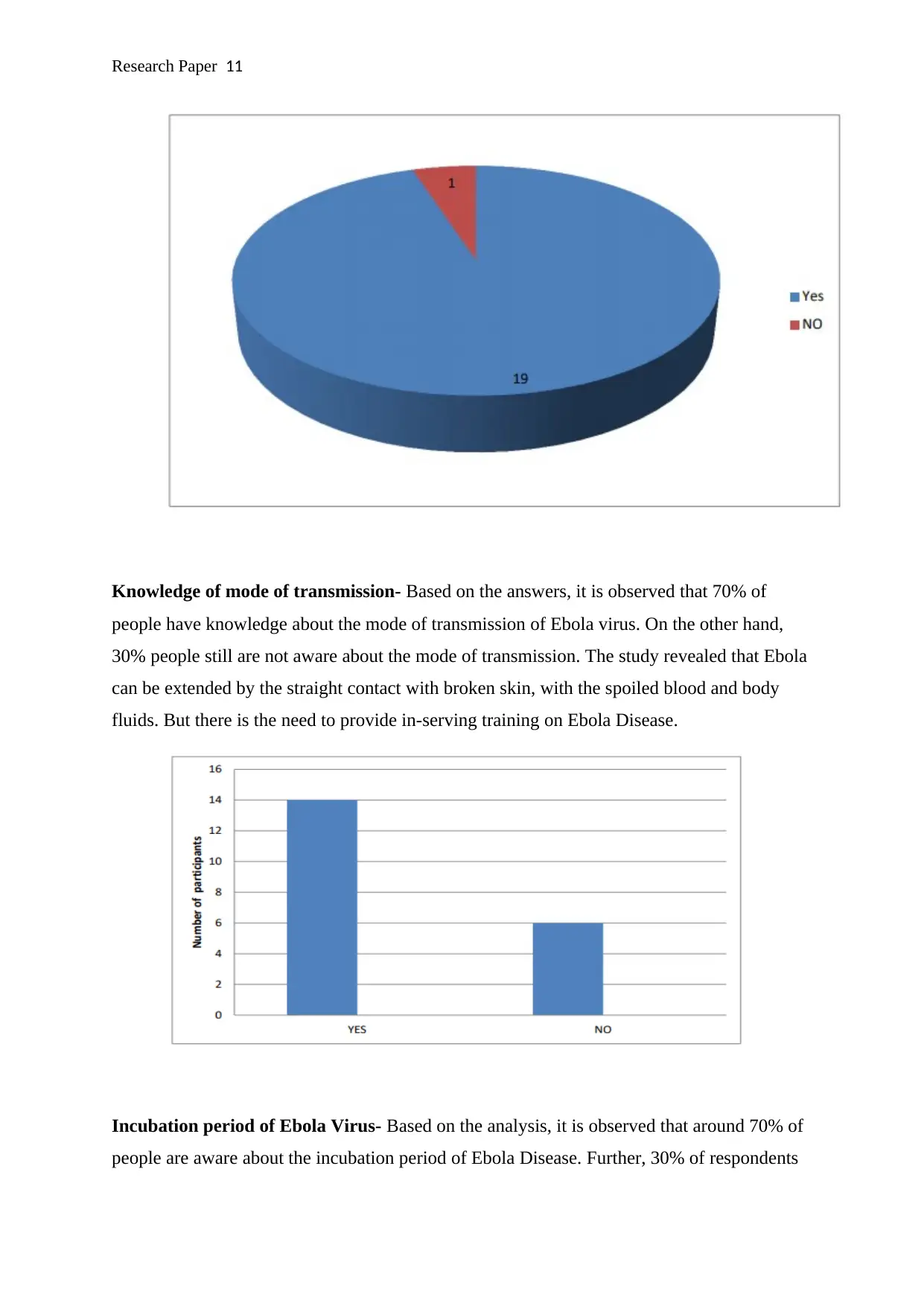
Research Paper 11
Knowledge of mode of transmission- Based on the answers, it is observed that 70% of
people have knowledge about the mode of transmission of Ebola virus. On the other hand,
30% people still are not aware about the mode of transmission. The study revealed that Ebola
can be extended by the straight contact with broken skin, with the spoiled blood and body
fluids. But there is the need to provide in-serving training on Ebola Disease.
Incubation period of Ebola Virus- Based on the analysis, it is observed that around 70% of
people are aware about the incubation period of Ebola Disease. Further, 30% of respondents
Knowledge of mode of transmission- Based on the answers, it is observed that 70% of
people have knowledge about the mode of transmission of Ebola virus. On the other hand,
30% people still are not aware about the mode of transmission. The study revealed that Ebola
can be extended by the straight contact with broken skin, with the spoiled blood and body
fluids. But there is the need to provide in-serving training on Ebola Disease.
Incubation period of Ebola Virus- Based on the analysis, it is observed that around 70% of
people are aware about the incubation period of Ebola Disease. Further, 30% of respondents
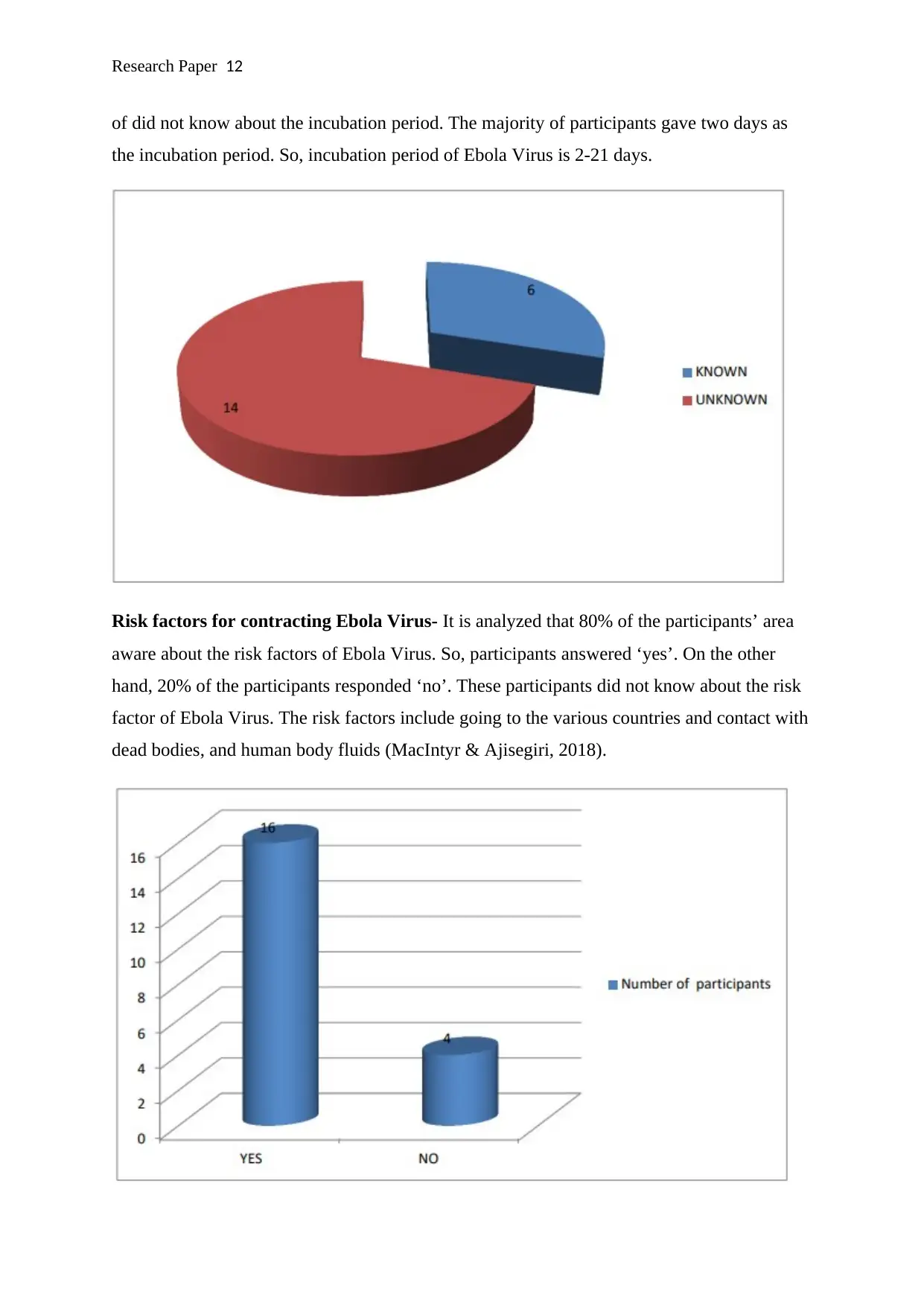
Research Paper 12
of did not know about the incubation period. The majority of participants gave two days as
the incubation period. So, incubation period of Ebola Virus is 2-21 days.
Risk factors for contracting Ebola Virus- It is analyzed that 80% of the participants’ area
aware about the risk factors of Ebola Virus. So, participants answered ‘yes’. On the other
hand, 20% of the participants responded ‘no’. These participants did not know about the risk
factor of Ebola Virus. The risk factors include going to the various countries and contact with
dead bodies, and human body fluids (MacIntyr & Ajisegiri, 2018).
of did not know about the incubation period. The majority of participants gave two days as
the incubation period. So, incubation period of Ebola Virus is 2-21 days.
Risk factors for contracting Ebola Virus- It is analyzed that 80% of the participants’ area
aware about the risk factors of Ebola Virus. So, participants answered ‘yes’. On the other
hand, 20% of the participants responded ‘no’. These participants did not know about the risk
factor of Ebola Virus. The risk factors include going to the various countries and contact with
dead bodies, and human body fluids (MacIntyr & Ajisegiri, 2018).
⊘ This is a preview!⊘
Do you want full access?
Subscribe today to unlock all pages.

Trusted by 1+ million students worldwide
1 out of 23
Related Documents
Your All-in-One AI-Powered Toolkit for Academic Success.
+13062052269
info@desklib.com
Available 24*7 on WhatsApp / Email
![[object Object]](/_next/static/media/star-bottom.7253800d.svg)
Unlock your academic potential
Copyright © 2020–2025 A2Z Services. All Rights Reserved. Developed and managed by ZUCOL.





